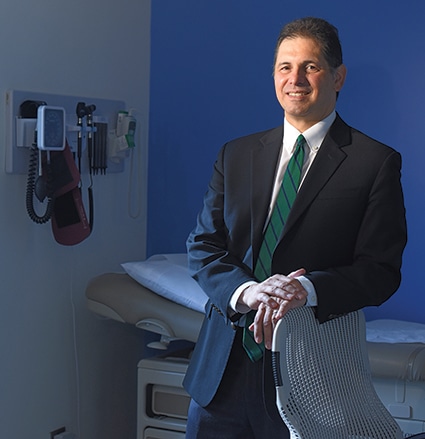Karen Titus
October 2019—Rarely (as waggish folks like to remind us) is it necessary to reinvent the wheel. Many times it’s better to take existing wheels and stick them on, say, a suitcase.
Suddenly, maneuvering through airports becomes 1,000 times easier.
Improvement can be that simple, so obvious in retrospect. At least that’s what kidney experts, both inside and outside the laboratory, are hoping as they promote use of the kidney profile lab order to diagnose and monitor chronic kidney disease.
Transformation doesn’t always require the thrill of the new. While new markers are always welcome, two stalwart tests—estimated glomerular filtration rate and urine albumin-creatinine ratio—can do plenty. They’re just not doing enough right now. As Joseph A. Vassalotti, MD, chief medical officer, National Kidney Foundation, and associate clinical professor, Icahn School of Medicine at Mount Sinai, New York, puts it: “There are many indications that the care of Americans with chronic kidney disease is suboptimal.”
The gulf between laboratory testing and patients’ awareness that they have CKD is disconcertingly wide. According to CAP Surveys data, approximately 90 percent of U.S. labs report eGFR along with serum creatinine results when creatinine is ordered, says Greg Miller, PhD, co-director of clinical chemistry, Virginia Commonwealth University Health System.
On the other hand, 2013–2016 data from the National Health and Nutrition Examination Survey showed that a mere eight percent of people with eGFR <60 mL/min/1.73 m2 knew they had CKD; for those with that same eGFR and a uACR >30 mg/g (3 mg/mmol), only 28 percent knew they had CKD. Even among patients with CKD stage G4, only about half are aware of their condition, says Dr. Miller, who is also chair of the Laboratory Working Group of the National Kidney Disease Education Program, or NKDEP.
The misalignment feels reminiscent of an earlier era in travel, when wheeled luggage meant bunglesome efforts involving carts and bungee cords. Nice try, but no.

Dr. Joseph Vassalotti, chief medical officer of the National Kidney Foundation. “I’ve had so many people tell me how frustrated they are that they didn’t know sooner they had kidney disease,” he says. “They wish they’d had a chance to do better.” (Photo courtesy of Jennifer Altman)
The fundamental idea, Dr. Miller says, is that “instead of ordering the basic metabolic panel, and remembering also to order the urine albumin and creatinine tests, you just order the kidney profile. If the patient’s at risk of kidney disease, order the kidney profile. Done. In my mind, it’s a simplification process. And a convenience—convenience of memory and convenience of simplification.”
To put the wheels on the suitcase, so to speak, leaders in the field are promoting the kidney profile, a term put forth roughly a year ago to encourage primary care providers to order the right tests (eGFR, uACR) on the right people (high-risk patients) at the right time (before CKD progresses).The stakes are high. Dr. Vassalotti doesn’t mince words. Using the kidney profile and acting on results “could save lives, literally. It could definitely improve lives.
“I’ve had so many people tell me how frustrated they are that they didn’t know sooner they had kidney disease,” he continues. “They wish they’d had a chance to do better.”
Adds Michael Rocco, MD, MSCE: “We have over half a million people here in the United States who have end-stage kidney disease [ESKD].” The best way to treat it? “Prevent people from getting ESKD,” says Dr. Rocco, who holds the Vardaman M. Buckalew Jr. chair in internal medicine/nephrology at Wake Forest School of Medicine and is chair of the NKF’s Kidney Disease Outcomes Quality Initiative (KDOQI).
The basic challenge, says Dr. Miller, is that patients with CKD do not have symptoms of their disease until it’s fairly advanced. The aforementioned NHANES data show that people who have CKD don’t know they have it, which means, of course, that nobody is trying to prevent disease progression, says Dr. Miller. “This is the problem that’s not well appreciated.” Hence the drive for a convenient tool—the kidney profile—that primary caregivers can use.
Clinicians would benefit from having one box to click, Dr. Rocco says. “At my institution right now, I have to click three boxes. If you’re seeing 30 patients a day, that adds up quickly.”
“Both tests need to be there together,” agrees James Fleming, PhD, vice president and director, Department of Science and Technology, LabCorp, which was an early adopter of the kidney profile.
The issue does not lie with the tests themselves (although there is room for improvement there, too), but rather, getting physicians to order them, says Dr. Miller. “The tests are common, and the tests have been recommended in the guidelines for years. But they’re not packaged in an easy-to-order way.” The destination has always been clear, in other words. But now experts are suggesting a new way through the maze.
“The real issue here,” Dr. Miller adds, “is the underutilization of urine albumin and urine creatinine in high-risk patients.” It might help conceptually, he says, to think of similar profiles, although there’s no perfect analogy. A lipid profile for cardiovascular disease comes close, but unlike the kidney profile, that’s not limited to high-risk individuals.
Among those considered high risk are patients with hypertension or diabetes mellitus, which includes about 75 million Americans, according to the Centers for Disease Control and Prevention. Multiple data, including from Medicare, the American Medical Group Association, and OptumClinformatics (a commercial insurance database), suggest that the vast majority—more than 90 percent—of patients with hypertension do not undergo uACR testing; approximately 60 percent of patients with diabetes or with both conditions go untested annually, says Dr. Vassalotti.
Similarly, he reports that a National Ambulatory Medical Care Survey (2006–2014) of more than 7,000 outpatient visits revealed that uncontrolled hypertension in the CKD population was 46 percent in 2006–2008 and 48 percent in 2012–2014 (P = 0.50). Uncontrolled diabetes was present in 40 percent of the CKD population in 2012–2014. Statin use to reduce cardiovascular risk among CKD patients ages 50 and older was low and remained unchanged, from 29 percent in 2006–2008 to 31 percent in 2012–2014 (P = 0.92). Kidney protective angiotensin-converting enzyme inhibitor (ACEi) or angiotensin receptor blocker (ARB) use decreased slightly from 40 percent to 36 percent (P = 0.07) (Tummalapalli SL, et al. Clin J Am Soc Nephrol. 2019;14[8]:1142–1150). The uACR test results inform the population with CKD that will have difficult to control diabetes and hypertension, Dr. Vassalotti notes, and guide the use of ACEi or ARB.
The laboratory is crucial not only to the diagnosis of CKD but also to risk stratification, he says. The lower the level of kidney function, the greater the risk—not only of kidney disease progressing, or for subsequent loss of kidney function over time, or of dialysis or transplant, but also for hospitalization, cardiovascular events, and all-cause and cardiovascular mortality. Elevated albuminuria (uACR) is associated with the same outcomes, he says, though perhaps less well known.
And in the hospital setting, the laboratory can help improve the diagnosis of acute kidney injury, defined as a sudden loss of kidney function, with a creatinine rise of 0.3 mg/dL or more over 48 hours, says Dr. Vassalotti.
Guidelines from groups such as the American Diabetes Association, the NKF’s KDOQI, and an international organization called KDIGO (Kidney Disease Improving Global Outcomes) have long called for annual eGFR and uACR testing.So why has it been so hard to get those wheels on the suitcase?
Education, says Dr. Fleming. “Just a lack of understanding that diabetes and cardiovascular disease are two major risk factors for chronic kidney disease. Whereas if someone has diabetes, everyone knows they should be treated preventively for cardiovascular disease.”
Part of the problem is lack of clinician awareness, Dr. Vassalotti agrees. “I think laboratories can help promote testing. And clinicians can test more thoroughly—there’s no question.” But he suggests the two are related.
Dr. Vassalotti cautions against being overly critical of clinicians. “We want to collaborate to integrate these simple, scalable changes in their workflows.”
The recent effort to promote the profile represents a sort of phase two for CKD testing. Most labs now measure eGFR, Dr. Rocco says, although “it was a struggle for 10 years. But now most labs have come around.”

Dr. Miller
Ordering of urinary albumin and creatinine has lagged behind eGFR, however. “There hasn’t been as much publicity around the importance of it, like there was for eGFR,” says Dr. Miller. Recognizing this deficiency, the NKF began its push to package the eGFR and uACR together. In some regards, this takes a page from Amazon’s playbook—an Others who bought this item also purchased approach that makes it easy to order both tests.
“If the tests are harmonized, are simplified, that will help stimulate clinician testing,” Dr. Vassalotti says. “Also, if labs report the results in a harmonized way,” that will increase clinician confidence in results that are produced in different labs—which is not an uncommon practice. Clinicians use different labs for the same patients for any number of reasons, including changes in insurance and patient convenience or preference. That can make it difficult for physicians and patients to interpret results and understand their nuances. “Sometimes the results could be related to different reporting formats,” Dr. Vassalotti says.
Even the widely used eGFR has a few rough spots in need of smoothing out. CKI-EPI is felt to be a better representation of eGFR and is the equation recommended for the kidney profile. But the isotope dilution mass spectrometry Modification of Diet in Renal Disease study and original MDRD study equations are still in use. “That, unfortunately, creates nuances in laboratory results that are related to the equation, not biology,” says Dr. Vassalotti.

Dr. Fleming
The MDRD equation was initially published in the KDOQI guidelines. It had several limitations, Dr. Fleming says, including that it was not validated above a filtration value of 60 mL/minute, nor was it based on a multiethnic study. “So we had to report a result above 60 mL/min/1.73 m2 as literally, ‘The result is somewhere above 60 mL/min/1.73 m2.’ Which could represent stage two CKD classification, or be perfectly normal.”
 CAP TODAY Pathology/Laboratory Medicine/Laboratory Management
CAP TODAY Pathology/Laboratory Medicine/Laboratory Management
